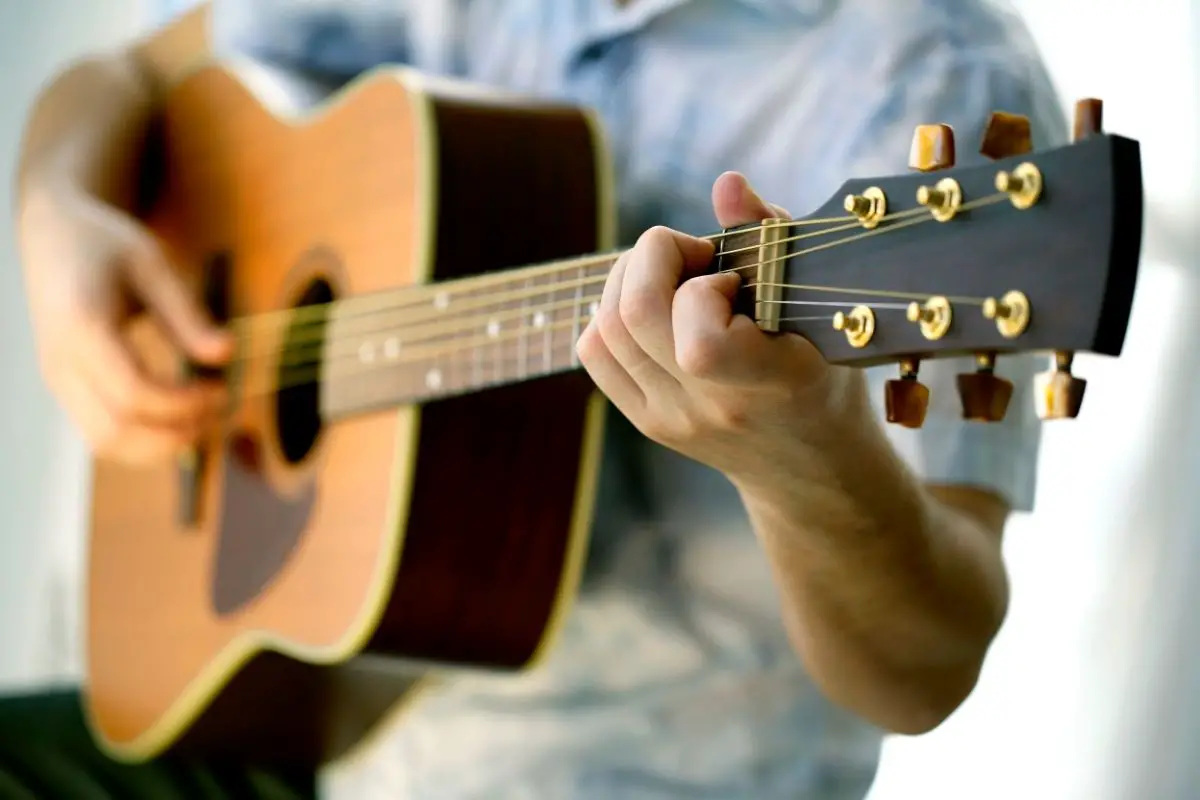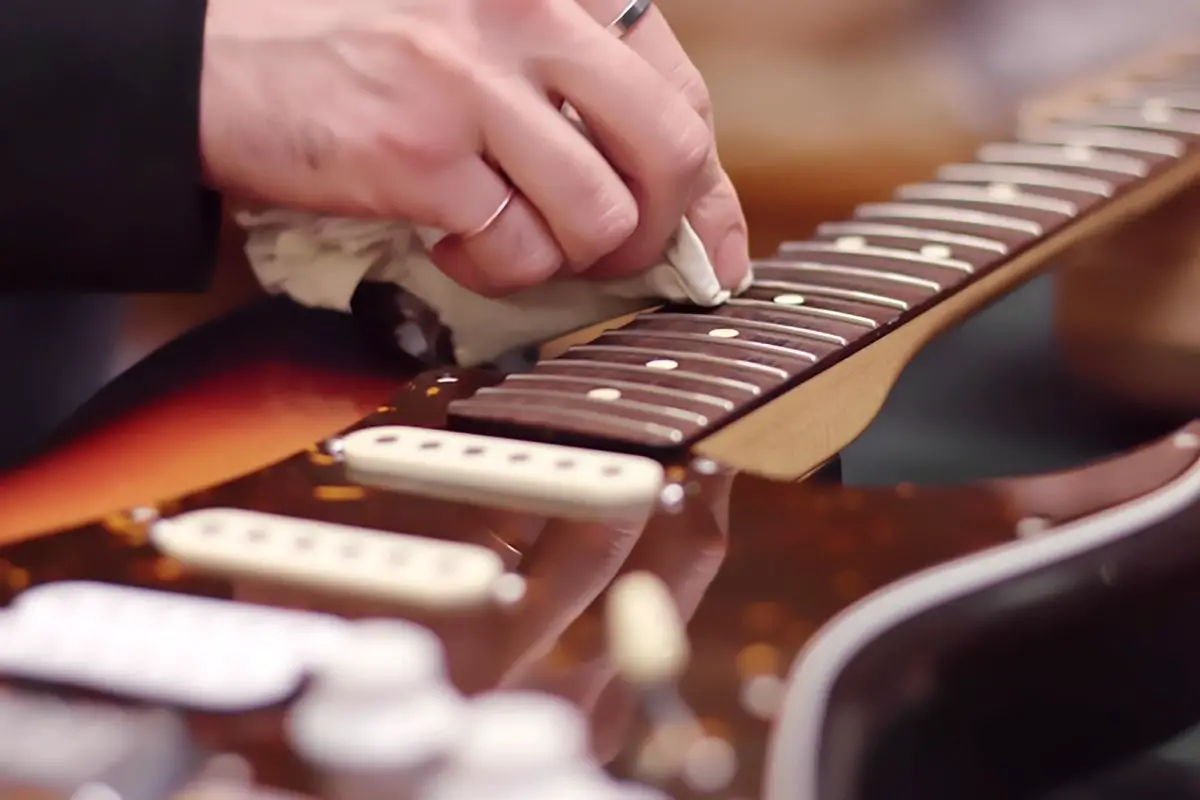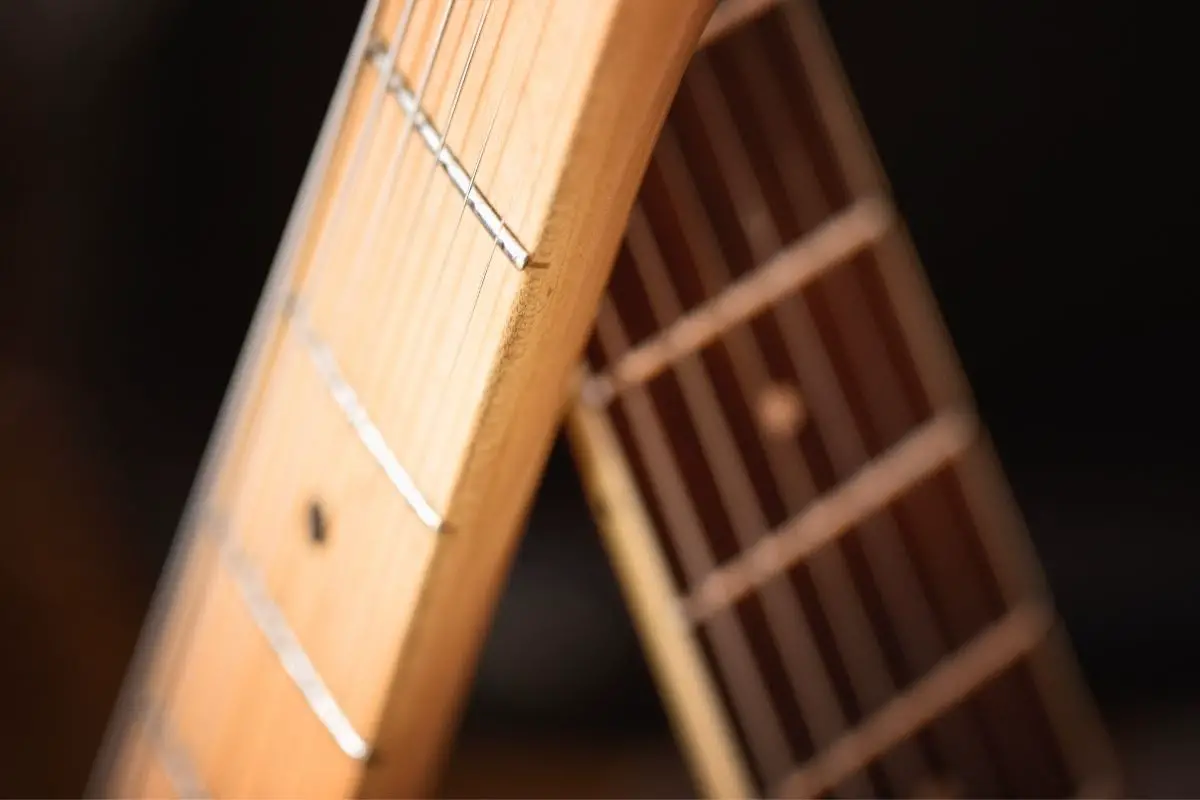When it comes to buying your first guitar, the sky is quite literally the limit. The world is at your fingertips, and while this is quite freeing, it can also make hunting for the perfect first guitar a little overwhelming.

As a beginner, there are some key questions you’ll need to ask yourself before making that first purchase, like what genre of music you intend to play, and how much money you have in mind for the instrument.
You will also want to consider if you have any prior experience of playing a guitar, and this could influence the perfect choice for you.
You may also want to consider whether you’d prefer an acoustic or electric guitar, as well as which features you’re looking for.
After all, there are lots of different types of guitars out there, and that can make selecting one very hard.
For instance, some types of guitars have several variations, each with different features. Acoustic guitar, for example, has about 4 variations, including the common classic acoustic guitar that’s perfect for beginners and the steel string acoustic guitar that’s ideal for heavier genres.
As you can see, wading through the guitar market can be very overwhelming.
But to help you out, we’ve compiled a list of all types of guitars done most of the leg work for you.
We’ve included information on the different types of guitars available, along with their pros and cons, so you know exactly what you’re getting into.
We’ll explain what each guitar type is, their unique characteristics, the style of music they’re best suited for, and who the guitar is best suited to.
In short, we’ll be providing you with all the information that you need to make a decision.
Check out this comparison table for our top recommendations on the various types of guitars:
So without further ado, let’s get into it and look at 20 different types of guitars!
List Of All Types Of Guitars
With the numerous types of guitars available, we have decided to expound on more types of guitars to help you make a better-informed decision. Plus, it helps to have more than one variety to strum to.
Our comprehensive list of 20 types of guitars includes more than the different variations of acoustic and electric guitars. We will talk about the bass guitar, hollow and semi-hollow guitars, acoustic-electric guitars, archtop guitars, and the tenor guitar, among others.
The Acoustic Guitar

Acoustic guitars are by far the most popular type of guitar out there. They’re a staple of the guitar family, and any player who’s serious about all things’ guitar most likely owns at least one.
They come in many shapes and sizes, but they all share one thing in common – they produce sound through vibration of the strings.
Unlike electric guitars, these don’t technically require amplification to make great sounds.
The body of an acoustic guitar is hollow. They have a sound hole that makes the strumming of its strings resonate inside the guitar.
They are usually made from wood, although other materials such as plastic and metal are used too. Acoustic guitars are often cheaper than electric guitars because they don’t require batteries or electronics.
These instruments are great if you’re just starting out because they don’t require any special skills to learn how to play them.
You can pick up a basic acoustic guitar for around $100-$200, depending on the model.
It’s a common misconception that all acoustic guitars are the same.
Whilst the differences between the types of acoustic guitars are subtle, more like variations on a theme, these differences can make a huge difference to the sounds they produce.
Here is a pick of my top recommended Acoustic guitar:
- Agathis top
- Sapele back and sides
- 3/4 Scale is perfect for beginners or children
- Includes Gig Bag
- Smaller Body style
Read on to see a breakdown of the different types of acoustic guitars.
1. Acoustic-Electric Guitars
The acoustic guitar is another popular type of guitar that beginners will learn from. But did you know there’s an acoustic-electric guitar, too?
That’s right! The combination of the electric and acoustic guitar allows acoustic guitars to be brought into orchestral or live performances thanks to the use of pickups.
Pickups are the only real difference between an acoustic guitar and an electric and acoustic guitar. The following pickups can be found on an electric-acoustic guitar:
– Piezoelectric
– Magnetic
– Microphone
Check out this top acclaimed option:
- Solid Spruce Top, Rosewood Back
- Rosewood Sides, Mahogany Neck
- Rosewood Fingerboard
- TP 4TD Electronics
- Gloss Natural Finish.Nut Width:1.6875 inches
2. Classic Acoustic Guitar

First off the bat, we’re talking about the Classic Acoustic Guitar. These types of guitars are a solid choice if you’re a complete beginner, or even for children wanting to learn the guitar.
Classical guitar strings are made out of nylon, as opposed to steel. This translates to the sound these guitars make, being mellow and understated.
They’re much smaller than their larger Dreadnought-style steel string guitar cousins, which makes them easier to transport and more comfortable for children to play.
The neck on a classic acoustic guitar is wider and flatter than its steel string counterpart, meaning that players have more room for intricate fretwork and wider cord forms.
Normal electric guitar pickups won’t work with these types of guitar, on a count of the nylon strings. You’ll either need a pickup designed for nylon strings or make use of a mic to get the amplification you want.
Classical guitars are used prolifically by players of classical, baroque, and renaissance music. But they also work for pop, R&B, and Jazz music too.
Pros
- Excellent for beginners
- Great choice for younger players
Cons
- Not suitable for electric guitar pickups
You won’t go wrong with this pick:
No products found.
3. Steel String Acoustic Guitar

By far the most common type of guitar, steel string guitars, produce a sound that is fuller and more robust than nylon string guitars.
This means that they’re perfect for heavier genres such as blues, rock, and heavy metal.
Steel string guitars are typically made of hardwoods like mahogany, maple, and rosewood, while the necks are often made from ebony.
You can find steel string guitars in various shapes and sizes, including dreadnoughts, arch tops, semi-hollows, hollow bodies, parlors, and auditoriums.
Jumbos and Dreadnoughts tend to produce a more bass heavy tone and louder volume, making them a great choice for aggressive lead playing and loud strumming.
Parlors and Auditoriums generally have smaller bodies, which gives them a more balanced tone and lower volume. They’re commonplace amongst players of finger style and mellow folk.
A good rule of thumb when buying a steel string acoustic guitar is to buy something that feels sturdy and well-built.
Another thing worth noting is if you choose a solid wood version, these need the most maintenance.
Solid body acoustic guitars need to be kept humidified, otherwise you run the risk of a warped or cracked soundboard.
Pros
- More robust sound than nylon stringed acoustic guitars
- Great for heavier genres of music
Cons
- Solid wood versions require a great deal of maintenance
- UK’s best-selling acoustic guitar
- Outstanding quality and value
- Hand-finished construction
- Select tonewoods for amazing sonic performance
- Slightly shortened scale-length for ease of playing
4. Flamenco Acoustic Guitar

One of the oldest styles of guitar, Flamenco guitars were originally made of gut strings.
These days, however, they’re usually made of nylon strings, much like the classical acoustic guitar.
They’re known for having an extremely fast tempo, and are played with a pick. The string height on a Flamenco guitar is traditionally lower, which adds to the speed they’re played at.
They’re very popular amongst musicians who play Latin American music, as it’s one of the few styles of guitar that uses open chords.
This type of music also lends itself to percussive hits to the strings and body of the guitar, you’ll feel that in the guitar when you play it
Flamenco guitars come in different shapes and sizes, but all feature a single cutaway design. This design lends itself to greater access to the upper frets.
Pros
- Fast paced and rhythmic
- Popular amongst Latin American musicians
Cons
- Single cutaway design may not suit your style of playing
- Solid Canadian cedar top with Indian rosewood back and sides
- Non-traditional flamenco tone woods, inspired by guitars played by Paco de Lucia
- Lightweight, with a slightly thinner body depth than a classical guitar
- Rosewood bridge and fingerboard,Scale Length-650mm (25.6″),Nut Width-52mm (2.04″),String Spacing at Saddle-60mm.
- Includes Cordoba gig bag
5. Twelve String Guitars
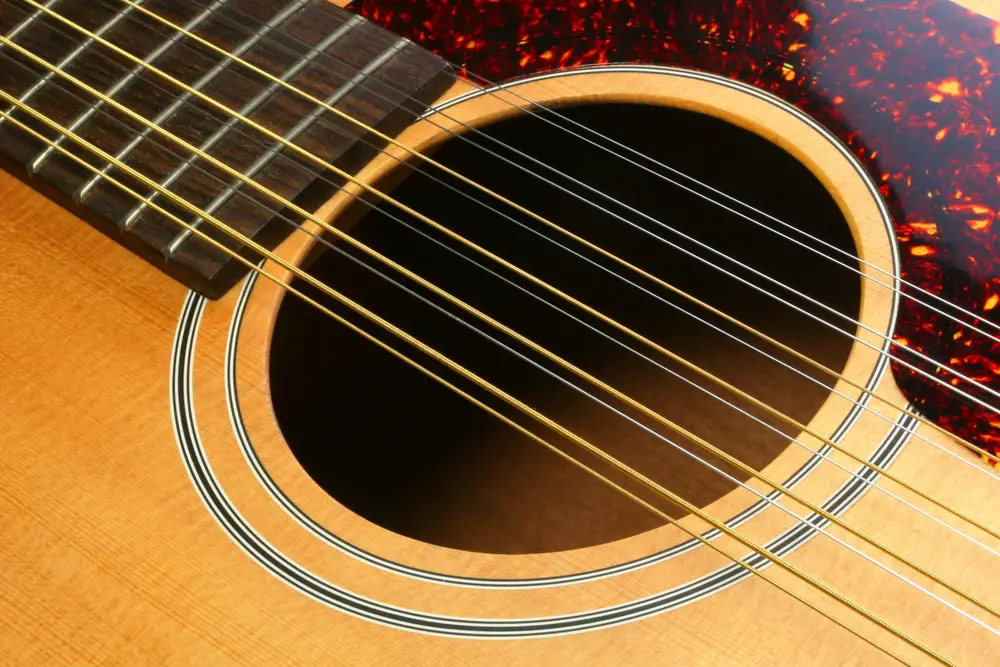
Most guitars have six strings, but did you know there are guitars out there with more? That’s right – some aspiring guitarists will be delighted to hear that there are twelve-string guitars out there.
These are a bit more difficult to learn than a six-string guitar, but it is worth it because of the rich sound that comes from a twelve-string guitar.
Twelve-strings are essentially the same thing as six-string guitars, but a player plucks two strings at the same time as opposed to just one.
This is where the richness in the tone comes from – but it is not the only place!
The tonal quality of a twelve-string guitar is due to the fact that specific strings are tuned an octave apart, which permits even more notes to be played!
You won’t go wrong with this most sought option:
- Whether you are looking for a birthday, Valentine’s Day, Christmas or graduation gifts, send this guitar to anyone that likes playing guitar or someone that just loves music. This could be an awesome gift for adults, kids who are just getting started with guitar.
- Perfect for beginner students or a young player, started ôn this beautiful instrument will have a good chance of loving the guitar.
- The body of the guitar is specially designed, and the natural curvature of the back is more ergonomic, which also gives it a larger sound cavity. When playing, you will feel its unparalleled tone.
- Spruce construction for eye-catching beauty, -lasting strength, and rich acoustic sound
- Most suitable for beginners, the sound is full and energetic, suitable for all styles of music, including rock, country, folk, blues, etc. Bring you a richer and brighter sound.
6. Resonator Acoustic Guitar

The resonator guitar was invented by George Beauchamp in 1892. It was designed to replicate the sound of a mandolin, but with the added benefit of being able to use higher notes.
It features a set of two parallel bars, which vibrate against each other when plucked. These bars are connected to the bridge, allowing the player to adjust their length.
There is usually a metal plate on the top soundboard of Resonator guitars.
The overall sound production on these guitars has a more metallic tone, and is unique when compared to the other acoustic guitars on this list.
It’s best used for picking out melodies, rather than strumming chords.
When choosing a resonator guitar, make sure the bridge is adjustable, as this allows you to change the tension on the strings.
You should also look for a guitar with a good quality finish, as this will help prevent damage to the instrument.
Pros
- Metallic sounding tones
- Easy to learn
Cons
- Not ideal for chordal playing
- Myers Pickups introduces their new lightweight powerhouse. So light that we named it The Feather. So compact that it can be positioned on a multitude of instruments without modification or permanent installation and still faithfully amplifies the natural tone and beauty of your instrument!
- Fully equipped with an internally powered, active preamp to produce the richest sound your instrument can deliver! Power-source (included) is pre-installed and each pickup is meticulously tested before delivery.
- Complete out of the box, plug in and play! All mounting hardware included. Instantly turn your instrument into an acoustic/electric instrument with volume! Compatible with almost any musical instrument! Made in the USA.
- (Instrument not included)
The Electric Guitar

An electric guitar is a guitar that can produce its own sound through amplification.
This means that, unlike acoustic guitars, there is no need for any additional instruments to create a full band sound.
If you take a side by side comparison of acoustic vs electric guitars, the differences in electric guitars becomes apparent, as there is greater variation.
However, some people prefer using an amplifier to add extra volume to their electric guitar. There are many types of amplifiers available, such as tube amps, digital amps, and even wireless systems.
If you want to amplify your guitar, then you should consider buying a preamplifier first.
This will give you control over the volume level, and allows you to connect the output from your amp or speaker directly into your guitar.
You’ll find that most electric guitars have either six or twelve gauge strings. Some players prefer heavier strings, while others prefer lighter ones.
Instruments such as Fender Stratocaster, Gibson Les Paul, Epiphone Les Paul, and many others have been manufactured since the 1950s.
Today, most electric guitars are constructed from solid woods, although some models do exist that are made from laminate woods.
Electric guitars are often preferred over acoustic guitars because they provide a louder output, and are easier to tune. Check out our overall pick of the best electric guitar:
- Three vintage-style ‘60s Strat single-coil pickups
- “Mid ’60s C”-shaped Maple neck; 7. 25”-Radius Fingerboard with 21 vintage-style Frets
- Alder Body
- S1 switch adds neck pickup to positions 1 & 2
- Includes deluxe Gig Bag
Most electric guitars have three main parts: neck, body, and headstock.
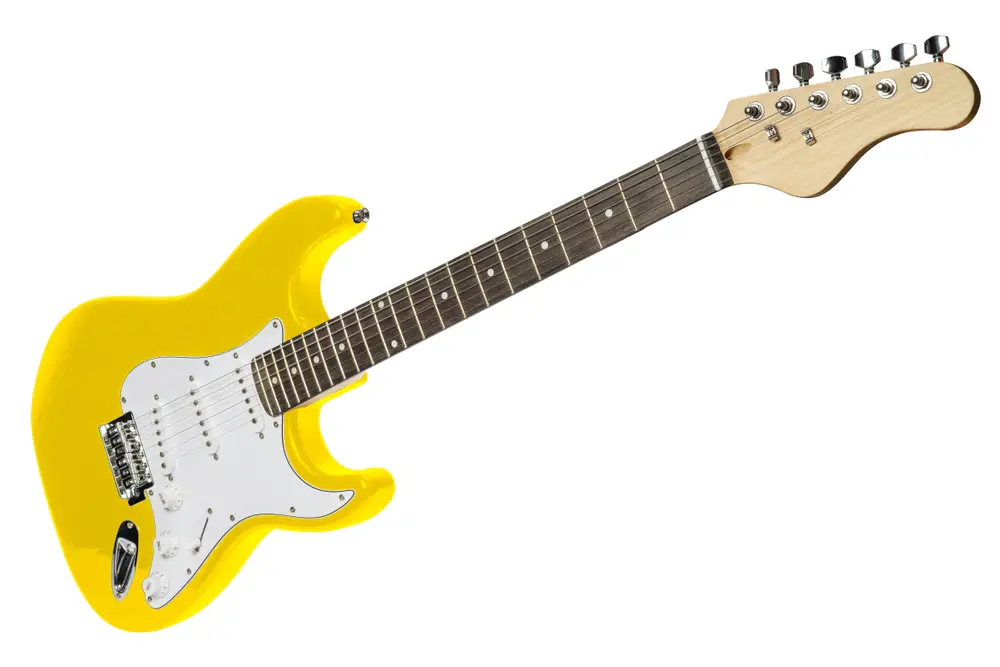
1. Neck
The neck is where the strings attach to the instrument. It’s typically made from either maple or mahogany wood, and features a fingerboard.
2. Body
The body is the part of the guitar that contains the electronics. Most electric guitars have a hollow body, although some models have a solid body construction.
3. Headstock
The headstock is located at the end of the neck, and is typically covered by a plastic cap. This is where the tuning keys are found.
4. Tuning Keys
These are located on the side of the headstock, and are used to tune the guitar to specific pitches.
They are shaped like a triangle, and are used to move the pegs up and down, thus changing the pitch of the string.
A few types of tuners include open gears, friction tuners, and electronic tuners.
5. Open Gear Tuner
Open gear tuners are very popular amongst beginners. They work by moving the entire headstock back and forth, which changes the position of the peghead.
6. Friction Tuner
Friction tuners are similar to open gear tuners, however they only move the peg head forward and backward.
7. Electronic Tuner
Electronic tuners are becoming increasingly common, especially amongst professional musicians. These tuners require a battery pack to be plugged into them, and then placed inside the guitar.
Once the battery pack is connected, the tuner will automatically adjust itself to the correct pitch.
There are different types of batteries available, including rechargeable ones.
8. Picks
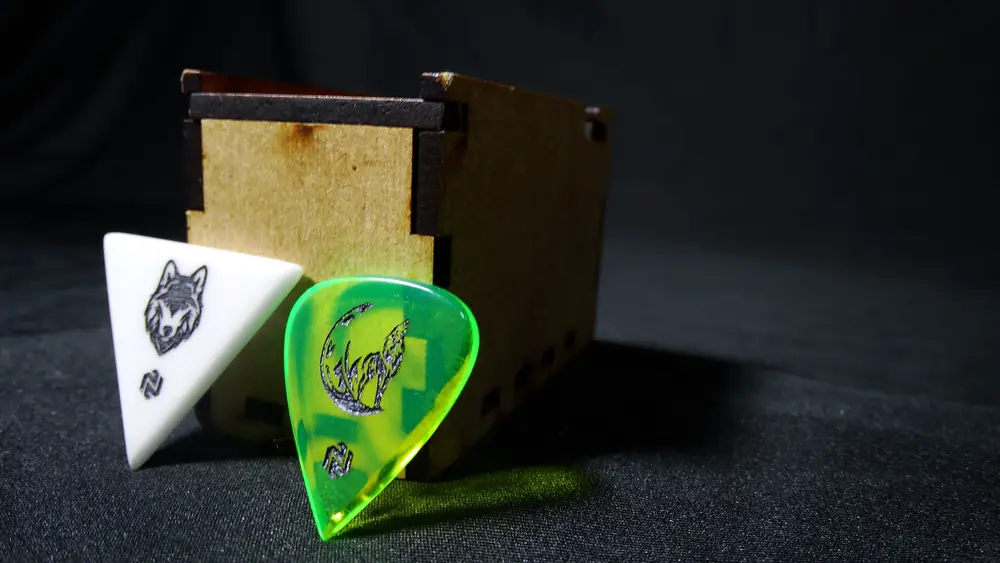
Electric guitars use picks, which are small pieces of plastic that fit between the strings and the fretboard.
Some players use both hands to play, while others hold the pick in one hand and pluck the strings with their other hand.
If you’re looking to buy your first electric guitar, it may be worth considering getting a starter kit.
These kits usually contain all the essentials needed to get started, including a guitar, amp, effects pedals, and even a microphone.
You’ll also find a strap, chord book, and a music stand.
9. Guitar Strap
Stands are essential when playing an electric guitar.
They allow the player to rest their left arm comfortably on the guitar, and keep their right arm free for strumming.
10. Chord Book
This is a great way to learn how chords should sound.
It’s a collection of songs written out in standard notation.
Solid Body Electric Guitar

Starting off our list of electric guitars is the solid body electric guitar, arguably one of the most popular types of guitars in the world.
Some of the most iconic and easily recognizable guitars, the Fender Stratocaster or the Gibson Les Paul spring to mind, are solid body guitars.
As you might have guessed from the name, this type of guitar features a solid body with no hollow areas. There are a few areas made for the electronics in the body, but the rest is completely solid wood.
The solid-body design has a number of benefits, including reducing feedback when playing at high volumes and keeping the strings sustained longer.
Those of us with excellent hearing notice the difference in the type of wood the guitar is made of, but the majority of tones produced by a solid body electric guitar comes from the pickup and electronics transmitting the signal.
These guitars are traditionally much thinner than acoustic guitars, which makes sense considering they’re solid wood.
The solid body electric guitar is best suited to high-volume/high-gain music found in rock and metal.
Pros
- Extremely popular and widely available
- Great for rock or metal music
Cons
- Beware of cheap makes
Stratocaster Electric Guitar

Next on our list is the Stratocaster. This type of guitar was originally designed for country music, but has become an icon for rock and metal music.
This particular model of guitar is often referred to as the “workhorse” of the industry. It’s been around since 1958 and has remained largely unchanged over time.
It’s also known as a Telecaster because it looks like a Telecaster, although the neck shape isn’t exactly the same.
This style of guitar is extremely versatile, making it perfect for beginners who want to learn how to play guitar.
Strats usually have a dual-cutaway body, which gives the player greater access to the upper frets on the neck.
There isn’t a guitar with such a wide range of custom parts that we can think of.
There are literally hundreds of companies making everything from tuners and pickguards to tremolo bridges for a custom look for the Stratocaster.
In fact, many famous guitarists began their careers with a Stratocaster.
Pros
- Easy to play
- Versatile
- Popular among musicians
Cons
- Can be expensive
- 100% Designed by Fender
- Single-coil Stratocaster neck and middle pickups, humbucking bridge pickup
- Thin and lightweight body
- 6-saddle hardtail bridge
- Satin finish neck
Singlecut Les Paul Electric Guitar

If you’ve ever seen the movie Back To The Future Part II, then you know what the Gibson Les Paul is. In the movies, Marty McFly plays his own version of the Gibson Les Paul.
The Singlecut Les Paul is one of the most iconic designs from the 50s. It’s endured to this day as one of the most copied guitar designs around.
Gibson created the single cutaway design to make it easier for players to reach higher notes on the fretboard.
It’s not just about reaching those higher notes, though. The single cutaway design allows for more room between the body and the neck, giving the player a wider area to work with.
The bodies on the Singlecut Les Paul are often made from mahogany, which compliments the warm tones these guitars can make, along with giving it some weight.
This weight can regularly be a challenge for unseasoned players, as it can make the guitar feel awkward and unbalanced.
It’s a very popular guitar for rock, metal, and jazz players.
The Les Paul is typically considered the king of electric guitars. It’s one of the first electric guitars to feature a hum bucking bridge pickup.
Pros
- Wide variety of models
- Popular among musicians
- Good for beginners
Cons
- Not great for blues or classical
- Extra weight can be challenging for new players
- Gorgeous 1.4″ thin Congo mahogany body, mahogany neck and premium 42mm bone nut for a warm, full tone with better resonance
- Rosewood fingerboard with 22 standard 2.7mm round head stainless steel frets 628 mm for better string pushing
- Latitude custom model alnico 5 pickups, vintage P.A.F tone pickups with fast dynamic response and great transparent tone
- 2 volume and 2 tone controls with 3-way blade switch, 18:1 tuner, Tune-O-Matic bridge with More easily adjustable rollers
- Latitude Guitar New LP Style NW1915 – Lightweight LP style electric guitar that lets you rock out while taking the weight off your shoulders, open humbucking pickups for greater output power, smooth feel and transparent tone, a tribute to the classics!
Super Strat Electric Guitar

The Super Strat is one of the most popular electric guitars out there. It’s a hybrid of a traditional Stratocaster and a Telecaster.
These guitars were initially developed by Fender in the 1950s, but became so popular that other manufacturers started producing them.
They’re still being produced today by various brands.
These guitars have a number of features that set them apart from other types of guitars. They have a solid body, which makes them much heavier than hollow bodied guitars.
They also have an offset headstock, which means they don’t sit perfectly flush against your shoulder when you hold them up. This creates a unique sound.
Some of the best examples of these guitars come from Jackson Guitars. They produce high quality instruments at affordable prices.
Pros
- Great for playing fast-paced music
- Very versatile
- Affordable
Cons
- Heavy
- Offset headstock may be uncomfortable for some players
- Comfortable “C”-shaped neck profile
- Three single-coil Stratocaster pickups
- Vintage-style tremolo bridge
- Includes free 3-month subscription to Fender Play, Frontman 10G guitar amplifier, padded gig bag, instrument cable, instrument strap and picks
- Available in Black or Brown Sunburst
Telecaster Electric Guitar

The Telecaster has been around since the 1930s. It was originally designed to replace the acoustic guitar, and later evolved into its current form.
It’s a classic instrument that’s easy to learn how to play. Most people who start learning guitar will pick up a Telecaster before any other type of guitar.
There are many variations of Telecasters available. Some of the most common include the Standard Telecaster, Deluxe Telecaster, Modern Telecaster, Vintage Telecaster, and the Telecaster Thinline.
The Standard Telecaster is the original model. It’s a standard size guitar with a bolt on the neck. The Telecaster features two single-coil pickups, one on the neck and one at the bridge.
The body on the standard Telecaster is usually a single cutaway and very flat with few bindings or contours.
Pros
- Easy to learn
- Versatile
- Classic design
Cons
- Can be heavy
- Neck joint tends to break easily
- THE LEGENDARY 39” ELECTRIC GUITAR | Full-Size Electric Guitar Instrument Delivers the Ultimate Musical Experience with 22 Frets, Comfortable C-Style Neck Profile, Classic 3-Ply Pickguard, Effortless 3-Way Pickup, Volume Control, Tone Control & Easy Access AUX Output Jack | Perfect for Beginner, Intermediate & Advanced Players
- GORGEOUS SOLID-BODY CONSTRUCTION | Premium 1950s Silhouette Retains All the Beautiful, Distinctive Features of the Original Style | Durable Single Cutaway Paulownia Wood Body, Handcrafted Maple Wood Neck, Vintage Metal Ashtray Bridge & Thick Black 3-Ply Pickguard | Smooth, Glossy Butterscotch Blonde Finish
- REVOLUTIONARY SOUND, TONE & STYLING | Versatile Mid-Century Design Offers Consistent, Enhanced Sound with Simple 3-Way Pickup Switch, Volume Control & Tone Adjustment Dials | Enjoy Professional Quality Resonance, Intonation & Sonic Variety from Brighter, Sharper Notes to Warm, Mellow, Bass-Like Vibrations
- EXTENSIVE PLAYER-FRIENDLY FEATURES | Our Authentic Electric Guitar Requires Minimal Maintenance, So Aspiring Rock Gods Can Focus on Their Craft | Quality Sealed-Gear Classic Tuners Prevent Dust & Dirt Build-Up for Many Years of Accurate Tuning, While Anti-Warp Wood Body & Neck Clean Effortlessly with a Dry, Soft Cloth
- ACCOMMODATES ALL STYLES OF PLAY | Beloved Styling Brings Genre-Defying Sound to Every Band or Solo Artist, Complementing a Wide Variety of Instruments & Musical Vibes Including Rock & Roll, Pop, Blues, Jazz, Country, Folk, R&B, Reggae, Punk & Beyond | Perfect Gift for Birthday, Christmas, Holiday, Graduation & More
Baritone Electric Guitar

Unlike regular guitars, a baritone guitar is traditionally tuned to A instead of E. This difference in tuning gives them a much lower range and a unique sound.
The six-string baritone is similar to a normal guitar, save for the longer neck and heavier body.
The Baritone has been used for decades in studios to fill out certain country music songs. Newer heavy metal bands also use the baritone with high-gain for heavy metal styles.
Unlike the other entries on this list, the Baritone tends to be used as a secondary guitar owing to its unique sound production.
Pros
- Unique sound
- Low cost
- Good for beginners
Cons
- Not meant to be played solo
- May not fit well with other guitars
- A killer 27” scale baritone guitar that’s ready to rock while still being affordable
- The classic offset double-cutaway design is made with set-neck construction for incredible tone and strength
- Includes a pair of ESP-designed humbucker pickups along with a TOM bridge and tailpiece
- Built with a mahogany body and a comfortable three-piece maple neck with roasted jatoba fingerboard and 24 extra-jumbo frets
7-String Electric Guitar
A 7-string guitar is a seven-string version of the 6-string guitar. It’s often referred to as a “jumbo” guitar because it can be quite large.
Most 7-string guitars are made using a combination of steel strings and nylon strings.
This allows the player to get more volume while maintaining a low pitch. Because of their larger size, 7-string guitars tend to be louder than standard 6-string guitars.
Because of the extra strings, 7-string guitars are harder to tune properly.
Pros
- Loud
- More powerful
- Hard to tune correctly
Cons
- Expensive
- Difficult to master
- 【HEADLESS ELECTRIC GUITAR】Batking’s headless guitar the fanned fret makes the effective length longer while giving it a wider range of sound. Headless electric guitar is very convenient to carry with you wherever you go.
- 【Material】 The headless electric guitar Body Material Ash with flame maple veneer, Neck Material is Multiscale Birdeye Fingerboard Of Luminous Inlay with dot luminous inlay on the top
- 【Brass Bridge】The Brass Bridge of guitar Fully made out of Bell Brass, Solid contact saddle, Fully CNC machined and quality plating, Easy for intonation.
- 【Rock Design】The design of the shape of the guitar body is inspired by the ROCK gesture. Tummy Cut and Countered Heel Polished, better fitting the human body more comfortable.
- 【Appearance Perfect】 The appearance of the guitar is perfectly finished, the surface through the matte nitrocellulose spray paint, so that the guitar looks very textured.
The Semi-Hollow And Hollow Body Guitar

These types of guitars have a hollow body, which makes them lighter than solid bodied guitars.
They’re typically cheaper than solid bodied guitars, but they lack the power and sustain of a full sized guitar.
Semi-hollow bodies are usually made from wood like mahogany, maple, or rosewood. They’re frequently smaller than full-sized guitars.
Semi-hollow guitars come in either an electric or acoustic format.
Acoustic semi-hollows are generally easier to find than electric semi-hollows.
Pros
- Cheap
- Lightweight
- Great for beginners
- Easier to play
Cons
- No sustain
- Less powerful
- Smaller body
Check out this popular Semi-Hollow-Body Electric Guitar:
The Archtop Guitar

An archtop guitar is any type of guitar that uses an arched top. These guitars were popular during the 1920s and 1930s.
It was the first guitar style to feature a round back and sides.
In the past, these guitars were considered the best sounding instruments. Many jazz players consider the archtop guitar to be their go-to.
This is due to their hollow body and etched F-shape holes, which gives them a warm tone.
In fact, the term “Jazz Box” is often given to archtop guitars, owing to their popularity with jazz guitar players.
Today, most people consider them outdated and old-fashioned.
Pros
- Great tone
- Vintage look
- Popular among musicians
Cons
- Heavy
- Difficult to play
- Limited selection
- 2 Humbucking Pickups – Transparent Black Burst
- Solidbody Electric Guitar with Poplar Body
- Amaranth Fingerboard
- Quilt Maple Top
- Maple Neck
The Acoustic-Electric Guitar

An acoustic-electric guitar is a hybrid between an acoustic guitar and an electric guitar. It refers to an acoustic guitar which has an electronic pickup.
The pickup makes it easy to plug in an amp or sound system.
If you already have an acoustic guitar, there are plenty of pickups available to use on your acoustic guitar. These can either be installed or taken out.
Whilst some people like having a pickup already installed, others would rather not drill holes in their acoustic guitar, so they use a pickup when needed and remove it when finished.
There are a lot of options out there in terms of electrics on an acoustic electric guitar. Some are available with battery powered pickups to boost tone and give EQ options.
Some models include effects pedals such as distortion and reverb.
Pros
- Easy to learn
- Good for playing live
- Can be used in different genres
- Great for recording
Cons
- Not suitable for all styles
Check out this Fender American Acoustic Electric Guitar:
- Cutting-edge acoustic-electric guitar
- 3-pickup configuration: Under-Saddle Piezo, Internal Body Sensor and N4 Magnetic
- Offers 5 distinct voice pairs – a curated collection of acoustic and electric voices
- Integrated forearm and back contour, and mahogany Modern “Deep C” neck
The Small Guitar
Small guitars are perfect for those of us with small hands or if your little one wants to start learning how to play.
It’s quite common for people to be able to adapt to a full-sized guitar after playing a small guitar, but sometimes it makes sense to get a smaller guitar that just fits better.
The Parlor Guitar

A parlor guitar is a small, lightweight guitar designed specifically for home practice. However, they can be seen in the recording studio should the need arise.
There are many parlor guitars that are considered to be pro level.
They’re a firm favorite amongst singer/songwriters and composers as they can provide high-quality tones but are a more comfortable size.
Parlor guitars are usually inexpensive and come in a variety of shapes and sizes.
Pros
- Affordable
- Portable
- Easy to learn
- Comfortable
Cons
- Low volume
- Hard to tune
- Mahogany back and sides provide a rich and balanced tone
- Grade “A” Sitka spruce top for strong and balanced projection
- The Mahogany neck with Ebony fingerboard provide comfort and a sharp attack
- Fishman-designed preamp
- A hard shell case and Limited Lifetime Warranty is included to help protect your investment
The Traveler Guitar

As you might have guessed from the name, traveler guitars are great for those of us who are musicians on the move.
They’re made to be playable, just much smaller than a regular guitar.
You might be considering a weekend away, or a camping trip, these guitars are incredibly easy to take with you.
However, there is always a tradeoff.
Traveler guitars are typically cheaper than other types of guitars. They also tend to be less durable. They also don’t tend to have the best tone, and aren’t that loud.
Pros
- Lightweight
- Easy to carry
- Cheap
Cons
- Less durable
- No sustain
- BUILT FOR TRAVEL: The Escape Mark III is a portable and travel-friendly version of your favorite at-home guitar that you can take anywhere and everywhere you go. Weighing 4lbs 3oz and measuring 30”, this will be your steadfast road companion.
- PERFORMANCE WITHOUT COMPROMISE: Our proprietary In-Body Tuning System eliminates the need for a headstock by relocating standard tuning machines into the body. Even though it’s small, it’s still crafted with a full 25.5″ scale experience with 22 frets.
- PROTECT YOUR INVESTMENT: This acoustic guitar includes a custom gig bag with storage pockets to protect your instrument. It measures 31.5” in the bag, so you can easily take it along—with help from the comfy padded shoulder straps.
- UNMATCHED FEATURES: Equipped with an under saddle acoustic piezo pickup, a custom onboard headphone amp, built-in tuner, 2-band EQ, and aux-in to jam with backing tracks. Mahogany body and black walnut fingerboard.
- TRUSTED EXPERTS: For over 3 decades, Traveler Guitar has been providing reliable, quality travel guitars and is a brand that touring musicians trust. Traveler Guitar’s mission is to create high-quality and portable instruments for mobile musicians.
The 1/2 Size Mini Acoustic Guitar

Nearly all guitars of this size are aimed at beginners, so they’re usually reasonably priced. That being said, don’t expect pro level quality or details at this price point.
The 1/2 size mini acoustic is perfect for young, novice players. Their small size makes them great for little hands to play, plus they are easy to store and travel with.
There are options for some trendy and unique finishes on these guitars to make them more fun and appealing.
Pros
- Affordable
- Fun
- Easy to learn
Cons
- Lack any refined quality
- Comfortable 1/2 size guitar, with standard tuning
- Layered Mahogany top, back and sides
- Nub one nut, 1. 875″ Width
- C-profile Mahogany neck; 22. 875″ Scale Length
- Satin polyurethane Body and neck finish
The Tenor Guitar

The Tenor guitar has been around for well over a hundred years. They are often on the small side and have only four strings.
A tenor guitar is a guitar tuned to CGDA. This means that each string is tuned to one octave above the next string.
Tenor guitars are frequently found in folk music and jazz.
They’re also often played by vocalists who need to sing higher notes.
Pros
- Easy to play
- Great for singing
- Low cost
Cons
- Requires more practice
- Less versatile than other guitars
- RUPR-IVY – Tenor Ukulele – Prism Series – w/ Bag
- Flamed Maple Top, Back & Sides, Ivy Fade Gloss Finish
- Maple Neck, Ivy Fade Gloss Finish – Walnut Fretboard & Bridge – Walnut Binding, Abalone Style Purfling & Rosette, Transparent Spray-over Color Fade Gloss Finish
- Tenor 432 mm Body – 70 mm Body Depth – 37 mm Nut Width- -18 Frets – Slotted Headstock with Flamed Maple Veneer – -Gold Plated Single Tuning Machines with Gold Plated Buttons
- Ortega Guitars Concert UWNY-TE strings – Includes Free Deluxe Gig Bag
Other Types Of Guitar
Whilst we’ve tried to maintain each category listed above, there are some guitars that defy being categorized.
This might be because they have unique characteristics or novelties, or are only used in niche music styles.
The 12-String Guitar

Whilst many guitar players like the sound of having 12 strings, the way these guitars are tuned can be confusing.
They’re tuned like a normal guitar, but each string is doubled to give you EEAADDGGBBEE. This means that you’re not playing 12 different strings, but six sets of strings tuned normally.
It gives your chords and notes a chiming, lush sound when played.
Most 12-string guitars are only found at the pro level, and the price is reflected in this. There are a few which cater to tighter budgets.
The Double Neck Guitar
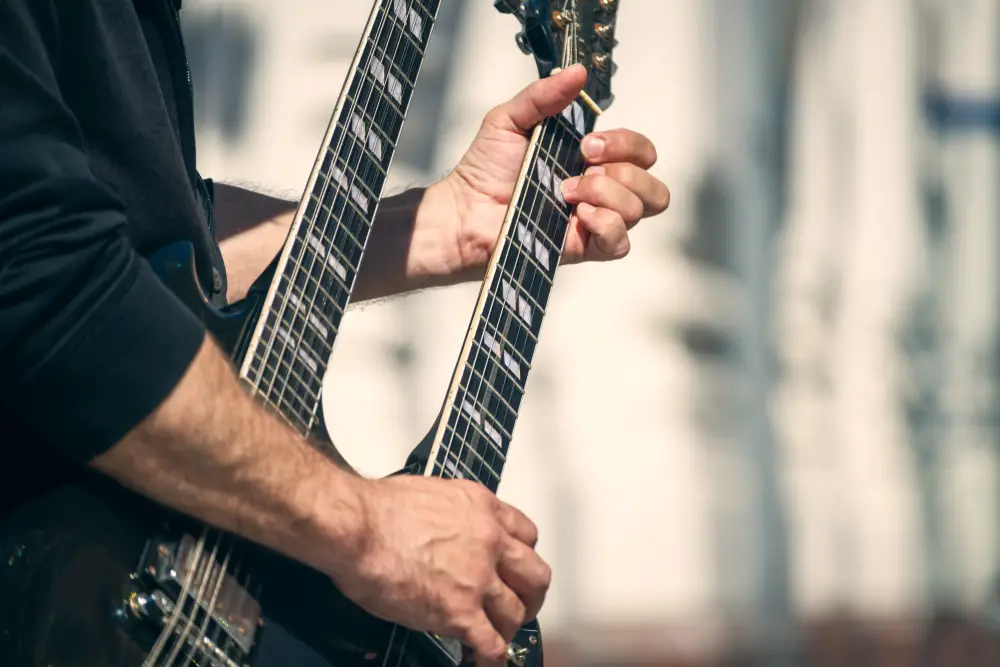
This is a guitar with two necks, one on top of another. They’re considered to be more of a novelty than practical, but they’ve been popular for decades.
Each neck has its own set of strings, allowing you to switch back and forth between the two. You can choose whether you want to tune both necks together, or just one.
You can even get double neck guitars with three or four necks!
These are great if you want to play songs where you alternate between the two necks.
You can also use them to create a chordal accompaniment.
Double neck guitars are very rare, and most of the ones you’ll find will be expensive.
The Steel Lap Guitar
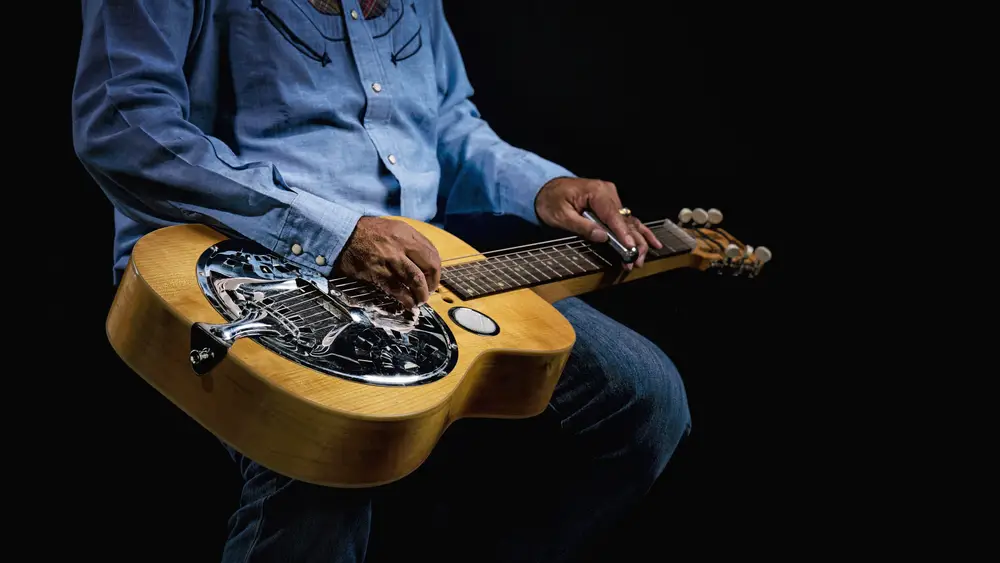
Steel lap guitars are made from steel, and are generally quite heavy.
They’re traditionally used in country music, although they can be found in almost any genre.
Most people consider Joseph Kekuku as the inventor of the steel lap guitar, and it’s been used by some very famous musicians on various tracks.
They’re made to be played using a slide and sit on your lap. Like other guitars made for a slide, the strings are very high, which makes it almost impossible to fret like a normal guitar.
Bass Guitars
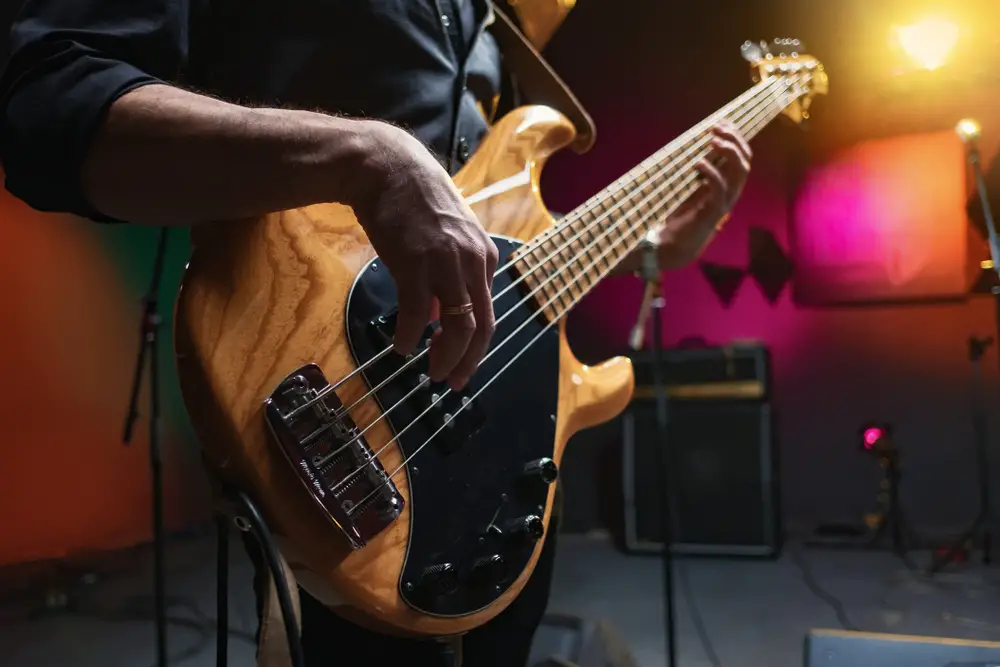
Bass guitars are also extremely popular in the world of music. You will often find them playing a significant role in rock bands throughout history, alongside electric guitars.
Bass guitars have long necks, especially in comparison to electric guitars, and also have a much longer scale length. The number of strings on a bass guitar can vary, but it typically sits between four and six.
If you decide you want to learn how to play the bass, then it is important to note that when it comes to tuning it, you will need to tune one octave lower than you expect.
On a normal guitar, the tuning happens on strings E, A, D, and G. This will be the same on a bass guitar, but just an octave lower.
15 Types Of Guitars You Never Knew Existed – Experienced Players
Even the most experienced players will discover new guitars.
If you’re a seasoned guitar player who’s grown a little bored of their usual musical instrument, then you should definitely check out the following guitars!
Resonator Guitars
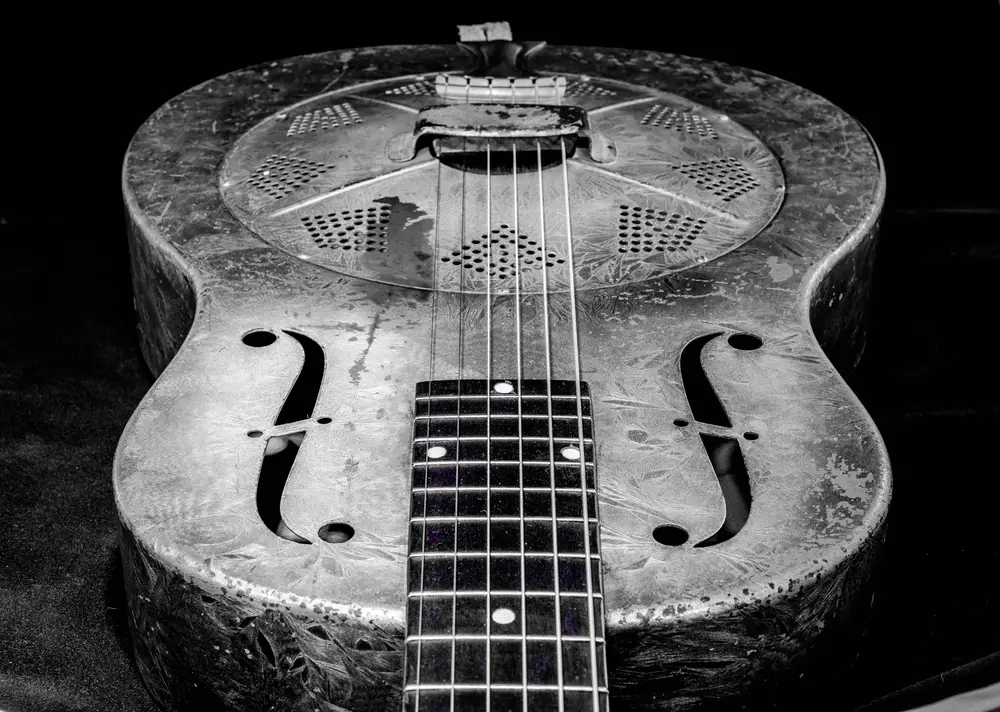
Resonator guitars, or resophonic guitars, are a little bit like acoustic guitars, but much, much louder!
Resonator guitars were made this way because when people tried to incorporate ordinary acoustic guitars into band and orchestral settings, their sound would be swallowed up by all the other instruments there.
So, like electric-acoustic guitars, resonator guitars were deemed to be a solution to this problem.
These days, resonator guitars are mostly used in bluegrass and blues music, and this is because of the distinct tone they make.
What tone do resonator guitars make? Resonator guitars produce a very deep, rich tone. They are usually tuned to C standard, and they can go up to Bb standard.
Upright Bass Guitars
Upright bass guitars are a type of electric guitar, also called an amplified double bass.
They have a thin body which makes them easier to transport from place to place – they are much, much lighter than electric and acoustic guitars!
Like other electric guitars, the upright bass guitar will sometimes come with hollow bodies, and at other times come with solid bodies.
The solid-bodied guitars will rely on an amp because they will not make an acoustic sound, but the hollow-bodied guitars will be fine to play without an amp.
Additionally, the hollow-bodied, upright bass guitars often have a wooden enclosure which will help them to produce a classic, acoustic sound.
This will be very useful for practicing, but not for live performances.
So, when it comes to live performances, it is best to invest in a hollow body amplifier so you can avoid your musical instrument being drowned out by others.
Harp Guitars
Harp guitars are a type of stringed instrument that was originally designed to accompany harps, but now they are used as solo instruments.
They are ordinary guitar necks that feature fretted strings and have been combined with many open, unstopped strings that create the harp section.
The strings can be plucked like a guitar, or strummed like a harp – the choice is yours!
But what makes it a guitar harp? Well, it is the open, unstopped strings. If you add just one of these strings, then the result is a harp guitar!
And there is no set number of open, unstopped strings you can have on your harp guitar, either.
Harp guitars can be played in any key, and they can even be tuned down to Eb standard if you wish. But they are usually tuned to A standard, and they can range from E standard to G standard.
Multi-Neck Guitars
Multi-neck guitars are extremely unique, and once you have mastered them, extremely fun to play.
The most common type you’ll see is the double-neck guitars, but you will also be able to find triple, quadruple, and sometimes five-neck guitars.
The most common multi-neck guitar out there, by now, is an electric double-neck guitar. The first neck typically has twelve strings, while the second neck usually has six strings.
However, the other popular combination is the electric double-neck that uses the bass guitar neck with four strings, and an acoustic guitar neck, which has six strings.
Many people who have played multi-neck guitars will discuss their convenience and weight with you.
So, naturally, the more necks your guitar has, the heavier it will become, and the more difficult it will be to play. To work around these difficulties, the best thing you can do is practice.
As for the sound of a multi-neck guitar, well, they’re pretty cool! Some players say that they can hear the difference between the two different necks, and some don’t notice the difference at all.
It’s up to you whether you want to try playing both necks at the same time, or just focus on one at a time. Either way, you should enjoy yourself.
Touch Guitars
Touch guitars are another type of guitar that is becoming increasingly popular.
These are guitars that feature touch sensors that allow you to play chords without having to use your hands – you tap, rather than strum.
These types of guitars are great for beginners because they make learning how to play easier.
What kind of touch sensor does a touch guitar need? There are two main types: capacitive and resistive.
Capacitive sensors require you to place your finger directly on top of them, while resistive sensors detect where your fingers go.
Touch guitars can also be multi-neck guitars!
As for their sound, touch guitars are very similar to regular guitars.
In fact, the only real differences are the lack of a pickguard (which protects the strings) and the absence of a bridge (which holds the strings).
This means that you won’t get the full experience of a traditional guitar when you play one.
Archtop Guitars
Archtop guitars have two very distinct features – an arched top, and an arched back. This makes them very different from ordinary guitars, which are usually flat.
Archtop guitars are popular in the following genres:
– Blues
– Rockabilly
– Jazz
– Psychobilly
Normally, you will find archtop guitars to be acoustic or semi-acoustic, and they will almost always have hollow bodies.
Additionally, the production styles of archtop guitars and other, regular guitars are very different. Archtop guitars have tops and backs that are usually press-heated or carved out of a solid wood block.
Archtop guitars tend to produce a much richer tone than normal guitars. They are often described as sounding “fuller” and “more resonant”.
Finally, archtop guitars may not be as easy to play as standard guitars, but they are certainly worth trying if you are looking for something new.
Other Types Of Guitars-Like Instruments You May Not Know Exist
Here are some guitars that you may not have known existed, or you may not have realized were actually guitars!
Mandolins
A mandolin is a guitar-like instrument that is also part of the lute family, and players usually use a pick to play it.
Mandolins typically have eight strings, and every string is tuned in unison. You will also be able to find ten-string and even twelve-string mandolins.
The history of the mandolin is interesting. Before modern strings, many musicians would play mandolins with six-string courses.
The strings themselves were made from animal intestines. These strings did not make a loud sound, and you would not be able to hear them from far away.
Luckily, steel-string mandolins came into play, and now they hold a great amount of tension thanks to being played with a pick, being much louder than the strings of the past.
While earlier mandolins would break if you attempted to string them with steel, new mandolins have a reinforced soundboard that is able to handle the tension well!
Banjos
Banjos are a type of guitar-like instrument that can come in a variety of string variations. On a banjo, you can find either four, five, or six strings, and this depends entirely on the model.
Banjos have very thin membranes that are pulled over the main resonator cavity. This is key to the sound of the banjo.
If you pull too hard, then you will create a buzzy sound. However, if you pull lightly, you will create a clear, smooth tone.
In the past, the resonator cavity would have been covered by animal skin, rather than the sheet of plastic used today.
Ukuleles
Like the mandolin, ukuleles are part of the lute family. These guitar-like instruments are strung with strings that are typically softer than steel, like nylon, or even gut.
Ukuleles have four strings but can sometimes come with two or three. Many people describe the four strings of a ukulele as “four courses”.
The ukulele also has an interesting history. It originated in the 1800s, coming from the Portuguese machete (a four-stringed, small musical instrument.)
When many Portuguese people immigrated to Hawaii, they brought their musical instruments with them, and eventually, the ukulele came to be. In Hawaiian, “ukulele” translates to “jumping flea.”
Did you know the ukulele actually comes in multiple different sizes? These include:
– The tenor ukulele
– The baritone ukulele
– The concert ukulele
– The soprano ukulele
Frequently Asked Questions
How To Choose A Guitar?
Choosing a good guitar is tough. You need to think about what kind of music you want to play, what style you want to play it in, and what size you want to play it.
We recommend starting out with something that’s easy to learn. It doesn’t matter too much if it sounds bad, as long as you enjoy learning how to play it.
Once you’ve got a grasp of the basics, then start looking into getting something better
How Many Types Of Guitars Exist?
There are so many guitars in the world today! There are six basic types of guitars: acoustic, electric, bass, slide, fretless, and double neck.
There are also other types of guitars, such as fingerstyle, lap steel, and lots more!
What Kind Of Music Do I Play On My Guitar?
There’s no right or wrong answer here. If you want to play rock, pop, blues, jazz, metal, folk, classical, reggae, hip hop, or anything else, you should be able to do so.
If you don’t know what kind of music you like yet, try listening to different genres. Try making up new words for different parts of songs, and see what you come up with.
If you’re trying to figure out what kind of music you’d like to play, look at the types of instruments you hear around you.
What Three Guitars Should I Own?
So you’ve mastered the basics of guitar playing and are now asking yourself if you should expand your arsenal of guitars.
Whilst these are completely up to interpretation, every guitarist should (and most likely does) own at least one of the following:
1. The Fender Stratocaster
2. A Decent Acoustic Guitar
3. The Gibson Les Paul
Why Are These Important?
When you’re deciding what type of guitar to buy, it’s important to remember that not all guitars sound the same.
Different guitars have different tonalities, and you’ll notice that certain guitars tend to sound better than others when you play them. This is because each guitar has a unique tone.
For example, an electric guitar might sound brighter than an acoustic guitar, and a bass guitar tends to sound lower than a guitar.
What Is The Rarest Type Of Guitar?
Many people think that there is only one rare type of guitar, but there are actually several rare types of guitars! Here are just a few examples!
1. Electric Bass – This is a special type of guitar that is played with a pick and has no frets.
2. Lap Steel – A lap steel guitar is similar to a regular guitar except it has a metal plate attached to the body instead of frets.
3. Double Neck – A double-neck guitar is a guitar where both necks are connected together.
4. Fretless – A fretless guitar does not have any frets at all. Instead, it uses a fret board that is placed under the strings.
5. Slide Guitar – A slide guitar is a guitar that has a metal rod stuck through the bridge. The player slides the rod up and down to change the pitch of the note.
What Are The Three Main Types Of Guitar?
Whilst we’ve broken the three main types down throughout this article, at a glance there are three main types of guitar, these are:
1. The Acoustic
2. The Electric-Acoustic
3. Electric
An acoustic guitar is usually strung with nylon strings, and is tuned to EADGBE. Electric guitars are often strung with steel strings, and are tuned to EADGBe.
Electric-acoustic guitars are similar to electric guitars, but they use both nylon and steel strings.
The difference between an electric guitar and an electric-acoustic guitar is that the latter uses both nylon and steel strings, whereas the former only uses steel strings.
What Is A Five-String Guitar Called?
Whilst the focus of this article has been all about the three main types of guitar, you might have heard people making reference to a five-string guitar. Bass guitars typically have five strings.
Wrapping Up
There are so many types of guitars out there, and they all have their pros and cons. It’s really down to personal preference.
Some people prefer the feel of a nylon strung acoustic, whilst others love the sound of an electric guitar.
There’s no right answer – it depends on what you want to achieve. If you’re looking to learn how to play guitar, then you should start off with a cheap beginner guitar.
If you want to make money from your music, then you should invest in a professional quality instrument.
If you enjoyed this article, you might enjoy our post on ‘What Guitar Does Wilbur Soot Use?‘

My name is Howard Matthews and I have been playing the guitar since I was knee-high. My parents like to joke that I was pulling the strings even before I was born. In fact, one of my earliest memories is sitting on the couch with my dad’s guitar, wreaking havoc on the chords.
Now, 40 years later, I can attest that I play them much better than I did back then. I have followed in the footsteps of both my parents – much to their delight – and have been the main guitarist in my band for the best part of three decades.
Music has always been my passion, and until recently my life has been so consumed with it that I haven’t had a moment to have a breath (and I wouldn’t have it any other way)!





















